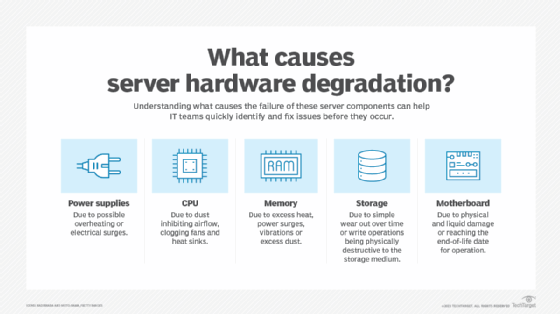
server hardware degradation
What is server hardware degradation?
Server hardware degradation is the gradual breakdown of the physical parts of a server.
There are several general areas where server degradation problems occur, including power, temperature, management and memory. The components inside servers age over time, and heat sinks and fans get clogged with dust, reducing the server's efficiency and performance.
Without proper monitoring and maintenance, server hardware degrades and fails over time, costing businesses productivity, profits and, possibly, their reputation. Server lifecycle management aims to mitigate the effects of hardware degradation by considering how and when servers should be replaced. Having visibility into the common causes of server hardware degradation enables IT teams to quickly identify and fix potential server issues before problems occur.
What's the typical lifespan of a server?
In general, servers can last anywhere from three to 10 years. Traditionally, IT teams swap aging servers for new ones approximately every three years to avoid hardware failure. However, with the adoption of server virtualization, products stay in production longer. Clustering technologies, virtualization features such as live migration and improvements in hardware all contribute toward server longevity.
Servers have an original equipment manufacturer (OEM) end-of-life date, specifying when an OEM will no longer market, sell or update server equipment. But the end-of-life date doesn't necessarily mean the end of a server's operational status. With proper and consistent maintenance, the life of server hardware can be extended. Pre-owned and refurbished servers, for example, can last much longer than the initial OEM's end-of-life date.
Organizations can still choose to replace server hardware every five years, depending on their strategy. For example, if an organization invests in a server that's already a few years old, it might want or need to replace that hardware sooner than if it purchased it new server -- or risk limiting itself in terms of features and connective hardware options. Likewise, an organization might adopt newer server hardware for optimal performance.
Organizations that keep server hardware for long periods with minimal maintenance might encounter server crashes, downtime and the potential for loss of profits.
Common server hardware degradation issues
There are several ways in which server hardware degradation can occur. As a server starts to degrade, performance issues can arise. Performance issues can include slowdowns, disconnections, outages and complaints from end users. If the problem isn't corrected, the server issue might eventually lead to a hardware malfunction.
Server hardware degradation typically occurs at the component level. Components most prone to failure include power supplies, memory and disks.
Power supplies. A server's power supply is responsible for supplying the correct amount of electric power to the server's various components. Although server power supplies are generally reliable, they can and sometimes do fail. The most common cause of power supply failure is overheating. Power supplies have built-in fans designed to keep the power supply cool. Over time, however, these fans bring dust and other contaminants into the power supply. If enough dust accumulates, it can reduce airflow across the power supply's components, causing heat to build up. In extreme cases, dust buildup can cause fans to fail, resulting in a power supply failure.
Power surges and lightning strikes can also destroy a power supply. These events cause the input current to spike to a level that's greater than what the power supply is designed to handle, destroying the power supply and possibly other components.
CPU. Dust can also pose problems for a server's CPU. If dust gets into a server, it can inhibit airflow and clog fans and heat sinks. This can cause a server's CPU to overheat. Most modern servers are thermally throttled, meaning that if the server gets too hot, it forces its CPUs to slow down to prevent damage. When this happens, it can produce noticeable performance degradation.
Memory. Memory is another server component that's sometimes affected by degradation. Several factors can negatively affect a server's memory and result in performance issues, data loss or system stability problems.
Memory problems are often attributed to excessive dust or vibration. Dust can prevent memory modules from making contact with the sockets in which they're installed. Similarly, excessive vibration can sometimes cause memory modules to become loose, causing them not to function properly. Like power supplies and CPUs, server memory can also be damaged by excess heat or power surges.
Storage. Devices such as hard disk drives (HDDs), solid-state disks (SSDs) and disk arrays are among the components most susceptible to degradation. HDDs contain spinning media platters and motorized heads that move across the surface of the disk. Like any other mechanical device with moving parts, HDDs simply wear out over time.
SSDs are also susceptible to wear, but of a different kind. Unlike HDDs, SSDs don't contain moving parts. Rather than storing data on spinning platters, SSDs retain data in flash memory cells. One of the biggest problems associated with the use of flash storage is that write operations are physically destructive to the media. Each time that data is written, the write operation degrades the cell. Each cell is rated to endure a specific number of write operations before the cell eventually fails. Flash storage vendors use wear leveling and other technologies to prevent SSDs from wearing out prematurely.
Despite mechanisms designed to improve durability and longevity, both SSDs and HDDs wear over time and eventually fail. Such failures almost always result in data loss, unless the disk is part of a disk array that has been configured to provide redundancy.
Although disk arrays protect against data loss, the failure of a disk within such an array can lead to decreased storage performance if the array uses a parity-based architecture -- such as RAID 5 or RAID 6 -- to safeguard data. When the data center operator replaces the failed disk, the parity information is used to populate the new disk with data. Performance only returns to normal when this rebuilding process is complete.
Other common causes of server hardware degradation include the following:
- Packet loss due to physical errors in the network switch configuration.
- Bandwidth congestion due to the amount of data sent to a destination exceeding the network capacity.
- Network latency increase due to a defective network device which then changes packet routes or paths.

Addressing server hardware degradation
Although server lifecycle management and hardware refreshes are important aspects of preventing server hardware degradation, there are other steps data center managers can take. For instance, whenever data is involved, an organization should transfer that data to working hardware.
For example, if the server hardware running an AWS hypervisor fails, Amazon Elastic Compute Cloud and OpenSearch Service can mark the hardware as defective and move running instances to working hardware. Other ways to address server hardware degradation include the following:
Air quality. Data centers are commonly equipped with filtration equipment that's designed to trap dust. This helps prevent dust from building up in servers, damaging power supplies, CPUs, memory and other components in the process.
Power supplies. Likewise, servers are almost always plugged into an uninterruptable power supply (UPS). A UPS has batteries that keep servers running in the event of a power failure. Most are also designed to act as surge suppressors to prevent servers from being damaged by electrical surges. Mission-critical servers also tend to be equipped with redundant power supplies that allow the server to function, even if the server's primary power supply fails.
Disk failure. Data center operators commonly have protocols in place to protect against data loss and performance degradation related to disk failure. Many data centers, for example, replace disks at predetermined intervals. This storage refresh strategy replaces aging disks before they have a chance to fail. Modern data centers also tend to avoid parity-based storage configurations to prevent these storage refresh operations from affecting the server's performance.
Monitoring health. A key strategy to prevent storage hardware degradation is to monitor server health. Monitoring software can, for example, detect fans that have failed or CPUs that are suddenly running at a hotter temperature than expected. Similarly, monitoring software can often detect an impending hard disk failure by looking at the disk's SMART (Self-Monitoring, Analysis and Reporting Technology) information.
FTP transfer. To prevent the loss of data if hardware fails, IT teams can use File Transfer Protocol for file transfers between systems for data backup.
Server clustering. To help create a system with no single point of failure, servers can be clustered to spread components over multiple physical machines. A hardware cluster can be active-passive, in which case some redundant servers are reserved for failover duty and don't run any applications of their own. A cluster can also be active-active, in which case all servers in the cluster run their own applications but also reserve resources to allow them to perform failover duty for each other.
RAID arrays. RAID arrays are a way of storing the same data in different places on multiple hard disks or SSDs to protect data in the case of drive failures. If one drive fails, then the other is still available for use.
Motherboard failure. Physical damage or reaching the end-of-life date can result in the failure of motherboards. Monitoring motherboards and replacing them when they're close to this date helps avoid potential outages.
Learn more about how to prevent and recover from server failures.






